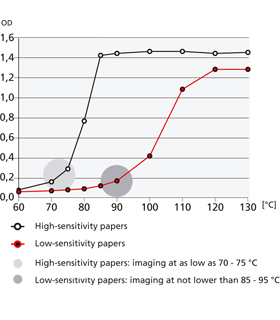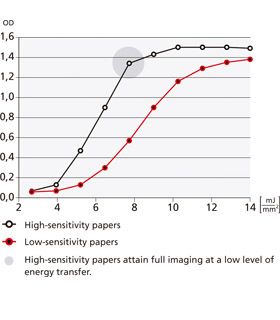The sensitivity of thermal paper refers to the degree to which it reacts to a given amount of heat or energy. Paper sensitivity is a decisive factor in the selection of the right thermal paper for your needs. It is usually depicted in graphs which plot the curve of image density or rather optical density (OD) against the amount of heat or energy transferred. Optical density is a measure of the relationship between incidental and reflected light. An optical density of approx. 1.1 is usually a full black to the human eye. Lower optical densities thus correspond to varying shades of grey. We distinguish between static and dynamic sensitivity.
Static sensitivity

The static sensitivity indicates the temperature at which a thermal paper will begin imaging. Thermal papers with low static sensitivity only begin imaging at high temperatures; thermal papers with higher static sensitivity begin imaging much earlier (between 70 and 75 °C).
Static sensitivity is very important if the thermal paper is to be used in high-temperature environments. Thus thermal papers with low static sensitivity are used for parking tickets, for example, since temperatures under the windscreen of a vehicle can exceed 80 °C on a hot summer day. The ticket must remain legible even under such conditions.
Dynamic sensitivity

The dynamic sensitivity of thermal papers indicates how fast a thermal paper can be printed. This is especially relevant in the selection of the right thermal paper for a particular thermal printer, since the higher the dynamic sensitivity of the paper, the faster the printer can operate without any settings having to be changed.
The respective static and dynamic sensitivity curves for all KANZAN thermal papers can be found in our complete range.